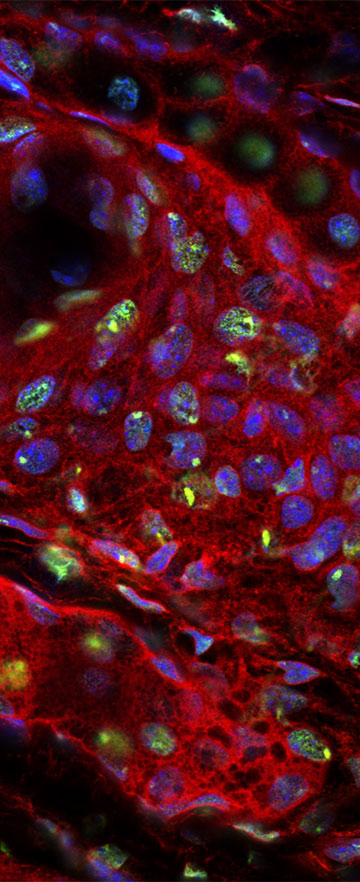Transform the lives of patients by harnessing the body’s regenerative potential through personalized autologous therapy
Company Overview:
At PolarityTE, we are focused on developing regenerative treatments for some of the most complex wounds—where disease burden on patients and families is immense and current therapeutic options are often limited or do not exist.

Our Focus:
At PolarityTE, our research is designed to deepen our understanding of skin’s complex regenerative cellular biology and use this understanding to develop new therapies for treatment of the most complex wounds, in patients with limited treatment options. We leverage our highly skilled in-house R&D team to rapidly move these strategies and therapies from bench to bedside, with the goal of delivering treatments to the patients that need them the most.
PolarityTE has an accepted investigational new drug (IND) application with the U.S. Food and Drug Administration (FDA) for the SkinTE® product, and has commenced its first pivotal clinical study under IND in diabetic foot ulcers (DFU) to generate the data that the FDA requires for submission of a biologics license application (BLA). FDA has designated SkinTE as a Regenerative Medicine Advanced Therapy (RMAT), which is reserved for products intended to treat, modify, reverse, or cure a serious or life-threatening disease or condition, where preliminary clinical evidence indicates that the drug has the potential to address unmet medical needs for such disease or condition.
Our current focus is on complex wounds, which encompasses both acute and chronic wound categories. A 2018 retrospective analysis of Medicare beneficiaries estimated that the prevalence of wounds in the US is around 8.2 million people.¹ Chronic wounds are wounds that fail to progress through the normal healing pathway and are open for more than one month and include DFU, venous leg ulcers (VLU) and pressure injuries—each of which represent a substantial unmet medical need.
34 million Americans are currently diagnosed with type II diabetes and, due mainly to vascular and neuropathic complications, and approximately 15% of them suffer from diabetic foot ulcer (DFU), an open wound commonly located on the bottom of the foot that can lead to hospitalization due to infection or other related complications (including amputation in 14-24% of patients). It is estimated that VLUs affect anywhere from 0.19%-0.23% of the general population and approximately 1 in 50 people over the age of 80 has a VLU. Studies show that the amount of these wounds remaining open longer than 12 weeks and therefore defined as “chronic” can be as high as 47%, which results in approximately 300,000 patients in the United States with VLUs that fail to heal with conventional treatments. Pressure Injuries (PI), known previously as pressure sores or bed sores, are defined as localized damage to the skin and/or underlying tissue, and arise as a result of pressure in combination with shear. 2.5 million people a year are affected by pressure injuries in the US alone and 500,000 will suffer a stage III/IV PI annually.
Acute wounds are recent wounds that have not yet gone through the stages of healing and include traumatic wounds, non-healing surgical wounds and burns. Similar to chronic wounds, acute wounds present a challenge to the healthcare system accounting for 17.2 million hospital, ambulatory and outpatients visits annually.² Non-healing surgical wounds and traumatic wounds are the second and third most common wounds in the Medicare population.¹ Non-healing surgical wounds are wounds remaining unhealed after a surgical procedure and have reported prevalence in the Medicare population as high as 3%.² Traumatic wounds include acute injuries such as abrasion, puncture wounds or crush injury. There are an estimated 84 thousand surgical procedures yearly for traumatic skin wounds.³ Burn injury remains a challenge despite advances in protocols and treatment options. Roughly half a million burn patients are treated annually in the US and the length of stay in the hospital for these patients is nearly double that of non-burn related stay.²
¹Nussbaum SR, Carter MJ, Fife CE, DaVanzo J, Haught R, Nusgart M, Cartwright D. An Economic Evaluation of the Impact, Cost, and Medicare Policy Implications of Chronic Nonhealing Wounds. Value Health. 2018 Jan;21(1):27-32. doi: 10.1016/j.jval.2017.07.007. Epub 2017 Sep 19. PMID: 29304937.
²Sen CK. Human Wound and Its Burden: Updated 2020 Compendium of Estimates. Adv Wound Care (New Rochelle). 2021 May;10(5):281-292. doi: 10.1089/wound.2021.0026. PMID: 33733885; PMCID: PMC8024242.
³DiMaggio, Charles et al. “Traumatic injury in the United States: In-patient epidemiology 2000-2011.” Injury vol. 47,7 (2016): 1393-403. doi:10.1016/j.injury.2016.04.002
Latest News:
[INSERT PRESS RELEASE WIDGET FROM EQUISOLVE]
Stock Quote:
[INSERT STOCK QUOTE WIDGET FROM EQUISOLVE]
